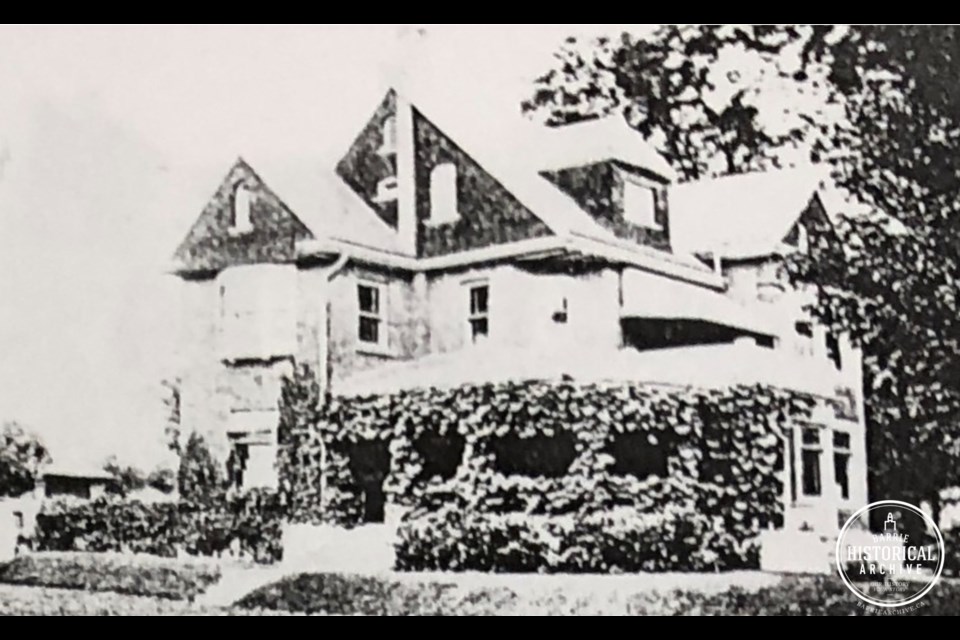This ongoing series from Barrie Historical Archive curator Deb Exel shows old photos from the collection and one from the present day, as well as the story behind them.
178 Bayfield St.
The house at 178 Bayfield St. was erected in 1895 for John H. Bennett and his wife, Fannie Augusta Meeking, after purchasing the land for $550 in 1894 from Hussey McCarthy.
The beautiful home was built by Toronto architects Edwards and Webster, based on a Queen Anne house design published in an 1889 issue of Canadian Architects and Builders.
Bennett started with the railway mail service in 1879 as a clerk and was promoted to chief railway mail clerk of the Barrie Postal Division in 1892, a position he held until it was abolished in 1897. His office had been on the upper floor of the old post office.
After his career in civil service ended, he established an insurance business.
Always interested in municipal affairs and finance, Bennett served as an alderman on the town council in 1898 and 1900. In 1899, when the Barrie Board of Trade was organized, Bennett served as secretary.
Bennett was also deeply involved in utilities, namely electricity. Monopolies controlled water, gas and electricity and in 1896, council was given a mandate by voters to look into municipally owned utilities in order to reduce rates and improve infrastructure.
At that time, Barrie’s ‘hydro’ came from the electric company’s generating plant in Midhurst, supplemented by a steam plant on Bayfield Street. By 1897, the electric company was in trouble. They offered to sell the light and gas companies in 1898 (they had acquired all the stock in the gas company) to the town of Barrie for $56,000 or $30,000 for just the light company.
They accepted the town’s offer of $22,501 for all the light company’s property and the plant (excluding the buildings, waterwheel and land in Midhurst).
Once public ownership of electricity was in place, (gas and water were also now in municipal control) all utilities were managed by the Town Water and Light Committee. A Public Utilities Act bylaw in 1901 made the water and light departments self-sustaining and in 1902, Bennett became chairman of the Water and Light Commission (predecessor to the Public Utilities Commission), holding that position until 1904. He was elected to their board in 1910, resigning the same year, then returning as chairman in 1919 until 1928.
In 1907, Bennett was elected mayor of Barrie and served in 1908. He continued to serve as reeve in 1912 and 1915-17.
J.H. Bennett had other interests beyond municipal service. He was a church warden at Trinity Anglican Church and had been president of the Barrie Curling Club, Barrie Golf and Country Club, West Riding of Simcoe Agricultural Joint Stock Co., and the Barrie Agricultural and Sports Arena.
His true passion, however, was floriculture and Bennett had a greenhouse behind his home to support his hobby. His gardens were a source of great pride — his specialty was peonies and his collection was thought to be among the best in Ontario. He was president of the Ontario Horticultural Association in 1914 and 1915.
The year 1926 was a particularly harsh one for Bennett. His younger brother, Senator William H. Bennett, who represented Simcoe East and who had been called to the senate by Canada’s eighth prime minister, Robert Laird Borden, passed away in April. Then in October, his beloved wife Fannie passed.
That same month, presumably in Fannie's memory, Bennett donated a special bed and electric sheet to Royal Victoria Hospital, to be placed primarily at the disposal of the poor in the public wards.
Bennett continued to live in his home at 178 Bayfield until his death in 1941. He and Fannie are buried at Barrie Union Cemetery along with his parents. The Bennetts had no children.
The next prominent occupant of the stately home was K.N.M. Morrison and his wife, Virginia. Kenneth Morrison was the manager of the Copaco from 1934 until 1953. The First Co-operative Packers (Copaco), opened in May 1931 and was considered “one of finest, most up-to-date meat packing plants in Canada."
The plant had a shaky start. Not long after opening, hog prices dropped and greater-than-anticipated start-up costs resulted in the plant shutting down less than a year later, in April 1932.
Following a great deal of drama involving management, the board, some court cases and a provincial loan, in June 1933 the Copaco was able to open again, although operating in a limited capacity. Magically, by mid-summer, however, the plant was producing bacon, sausages, a full line of hams and its top-selling wieners once the community realized that by supporting the local company through their orders and purchases, it created jobs, helped farmers and was good for the economy.
Kenneth Morrison, the successful plant manager, passed away in 1959, and the elegant home at 178 Bayfield changed hands again.
It’s been over a year since I’ve been inside the magnificent old home at 178 Bayfield St., but from attic to cellar, it is still in marvellous shape!
For several years until about 2018, Rinaldi College of Aesthetics resided in the gracious old home. The Rinaldis meticulously restored and maintained this beautiful property, as they have with their other important heritage building, the impressive 58 Collier St.
Today, multiple businesses are located in this charming house on Bayfield.



